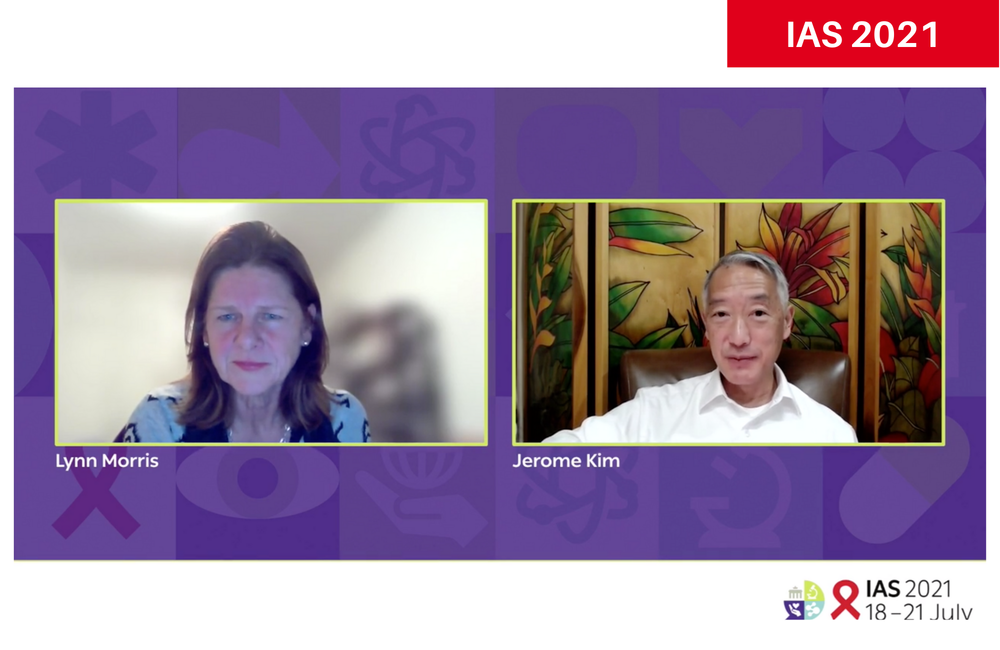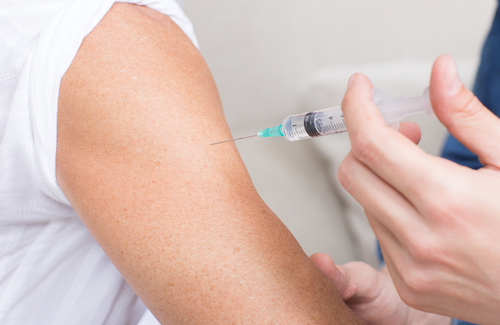
“Money does solve problems, there’s no question!” This was the answer by Professor Lynn Morris of the University of Witwatersrand in South Africa to an audience member at the 11th International AIDS Society Conference on HIV Science (IAS 2021) last week, in a plenary dealing with HIV vaccines and immunotherapy with antibodies.
If HIV vaccine research, she added, had had the sort of funding devoted to COVID-19 in the last 18 months, it would have enabled many more overlapping trials of different concepts. The finance would have encouraged the pharmaceutical industry to get more involved and use its ability to conduct large trials and manufacture successful products at scale.
Morris, who was a Principal Investigator in the AMP trial, which used a broadly neutralising antibody (bNAb) against HIV to see if it could prevent HIV infection, said that currently there are eight COVID vaccines approved for use, and 32 undergoing efficacy testing. In contrast, there have only ever been seven efficacy trials of an HIV vaccine, and only one that even gave a weak signal of efficacy.
However, in her plenary talk, Morris emphasised that HIV is inherently a more difficult organism to make a vaccine against than SARS-CoV-2, the virus that causes COVID-19. We may not have seen the last of the disappointments that have characterised this field, the last one being the failure of the HVTN 702 (Uhambo) trial.
Nonetheless, she added, even if the vaccine efficacy studies currently underway produce more negative results, there is a proliferation of preclinical studies of other concepts, and in particular of bNAbs, of which AMP was only the first efficacy trial.
Although these exceptional and potent antibodies have only been trialled in humans as passive immunotherapy (i.e. injected into the body like a drug), the same technology that was used to make the Moderna and Pfizer RNA COVID vaccines could in theory do what they did – induce cells in the body to make viral proteins that the immune system’s B cells then make antibodies against.
In fact, Moderna initially intended their technology to be used against HIV and at this year’s Conference on Retroviruses and Opportunistic Infections (CROI) they announced promising results from a study of an HIV RNA vaccine in monkeys.
What has to happen for an HIV vaccine to work
There are a number of reasons why HIV is a far bigger challenge for a vaccine than a more typical virus like SARS-CoV-2. Whereas the natural immune reaction to SARS-CoV-2 sooner or later clears the virus from most people’s bodies, HIV is not cleared. There is no naturally effective immune response, so a vaccine has to be “better than nature” to work.
As a retrovirus, HIV, instead of being eliminated, disappears by integrating into our own cells’ nuclear DNA, where it is invisible to the immune system.
It is also far more variable and mutable than SARS-CoV-2, and can develop resistance both to drugs and to antibodies more easily.
Eventually, after many years, a few people do develop the so-called bNAbs. These unusual, hyper-mutated antibodies could guard against viral infection if they arose immediately in response to HIV exposure. But they don’t – and no-one yet knows how to speed up their process of formation.
Finally, in COVID, the immune system reacts sharply to one component of SARS-CoV-2, its spike protein. It has become apparent that no one component of HIV creates a strong or broad enough immune response, and any vaccine or antibody combination would need to target several different sites on the HIV viral envelope.
It is this last factor, Morris explained, that may have doomed the Uhambo vaccine. The RV144 vaccine from 2009 – whose mild efficacy remains the only evidence that an HIV vaccine can work at all in humans – was given to volunteers in Thailand with less genetic variation in their HIV than the highly divergent viruses that developed in the generalised epidemic in southern Africa.
As a result, in the Uhambo study, there was a weaker antibody response to one crucial component of the HIV envelope – the so-called V2 loop.
The RV144 volunteers were also less at risk of HIV exposure than those in the Uhambo study. Even if a vaccine lowers the risk of infection with one exposure, where exposures are frequent, eventually one of many will get through.
There are two phase III efficacy trials underway, HVTN 705 (Imbokodo) among African women and HVTN 706 (Mosaico) among gay and bisexual men and transgender women. These aim to strengthen the immune response by containing antigens from many different viral subtypes (hence the name Mosaico). Results from these trials are expected in 2022 and 2023.
We must hope these vaccines succeed, but if they fail, Morris said, then they will probably be the last ones designed to elicit non-neutralising antibodies. These less specific antibodies do not interfere directly with viral replication. However, by proliferating in large amounts they signal to the other two branches of the immune system – the innate and cellular branches – that they should mobilise the natural killer cells and T-suppressor (CD8) cells that secrete virus-fighting chemicals and kill infected cells.
In contrast, bNAbs are able to interfere directly with HIV’s ability to enter cells, having evolved over years to penetrate its defences such as its coat of sugary ‘fuzz’ (glycans) and crucial viral mechanisms that open only for a short moment during the infection sequence.
Reverse-engineering an effective immune response to HIV
The cells in the bone marrow (B-cells) are the ones that make antibodies through a process of maturation. One approach to developing a vaccine to generate bNAbs has been to ‘reverse engineer’ them – to trace them back genetically to an Unmutated Common Ancestor (UCA) cell.
“People have gone to great lengths to find UCA cells and then map out the co-evolutionary path followed by the race between virus and host that eventually allowed bNAbs to develop,” Morris commented.
The process by which B-cells as close as possible to a UCA are selected and then, through sequential exposures to a specific viral antigen, induced to generate bNAbs to it, is called germline targeting. This approach has already produced positive results in monkey studies, and the concept is explained by researchers at the Scripps Institute in California. Human studies are now underway.
Germline targeting is one way to get round a general problem in HIV vaccines, which is called immunodominance. This means that the immune system ‘prefers’ to make large amounts of non-neutralising antibodies against certain viral antigens, rather than make the more effective bNAbs against the highly-conserved regions of the virus that it can’t change to escape immune system activity.
One of the most interesting targets is HIV’s fusion peptide, a tiny but essential part of HIV’s gp41 envelope protein that is the first viral component to pierce the host cell’s membrane. This can be one of the germline targets or can also be used as an antigen in a vaccine itself.
At this year’s CROI, scientists reported on another kind of vaccine. It was a therapeutic vaccine aimed at controlling the virus in people with HIV, that was able to induce the immune system to make, in this case, CD8 cells rather than antibodies against highly conserved regions. (Therapeutic vaccines need to stimulate the CD8 response as that is the only branch of the immune system that can kill cells that are already infected.)
Because an HIV vaccine may need to ‘educate’ the immune system to hit the right targets, the process of vaccination may need to take place over time. The scientists at Scripps have devised an ‘osmotic pump’ similar to a drug implant that releases vaccine antigens slowly over time. Alternatively, vaccines may need to be given in multiple doses that escalate over time and also change in composition in order to steer the intended immune response towards effectiveness.
Numerous passive-immunisation studies underway
In the meantime, while we continue to anticipate a truly effective vaccine, bNAbs can also be used as passive immunotherapy – essentially as a drug.
Indeed antibody-based therapies have been the fastest growth area in all pharmaceuticals for the last decade or more, particularly in cancer research, as they can finely target cancer cells. There is already one licensed HIV drug that is an antibody, the fusion blocker ibalizumab (Trogarzo).
Professor Morris ran through the results of the AMP study again. Although the single bNAb used in the trial, VRC01, was overall not effective in preventing HIV, it was 75% effective in preventing infections with the one-third of viruses that were most susceptible.
Subsequently, however, it has been found that the average antibody concentration needed to neutralise viruses in people who acquired HIV during AMP was 2.4 times higher in those who had received VRC01 than people who had received placebo. In theory at least, this could increase the risk of HIV infection in some people receiving VRC01 as PrEP.
In other words, bNAb treatment which is insufficient to suppress HIV can quite quickly cause resistance – just like any other drug.
To avoid this, more potent bNAbs will have to be used in combinations, and they may have to be given at high doses – a possible barrier to acceptability for a therapy mainly given by intravenous drip.
There is fortunately what Morris called a “robust” pipeline of studies of combination bNAb candidate regimens in progress. There are currently eleven human studies underway. Most are at phase I (safety and immunogenicity) but two have already got to phase II (dosing and preliminary efficacy).
Six involve injecting the antibodies subcutaneously (under the skin) as well as intravenously. Most involve two antibodies directed at different HIV target antigens, while some involve three or four. Two of the studies do not involve different individual antibodies, but instead use multi-specific ones, artificial antibodies combining differently-specific antibodies on the same molecule.
The studies involve 15 individual antibodies targeting four different areas of HIV’s envelope protein: the CD4 binding site (six), the V3 loop (five), the V1 and V2 loops (two), the gp41 protein/fusion peptide (one) and ibalizumab, which attaches to the host cell’s CD4 receptor rather than the virus’ binding site. The gp41 antibody and ibalizumab are combined in the first study of a multi-specific antibody; another combining three antibodies on one molecule is about to start.
Individual antibodies under study are capable of neutralising twice as many viral strains as VRC01. Combinations of two are able to neutralise up to 80% and three up to 90% of viruses.
What is just as important for progress is that new formulations of antibodies have been developed that greatly increase their persistence in the body. In AMP, concentrations of VRC01 fell from levels conferring 45% prevention efficacy immediately after a dose to 20% within two weeks. Levels of a triple combination of long-lasting antibodies against the CD4 binding site, the V3 loop, and the V1-V2 loops were still at 90% of their original prevention efficacy 15 weeks after administration. This combination will be going into a phase I human study in September.
Morris commented that “passive immunisation could have a major impact on HIV prevention in high risk groups” and although there may be barriers of formulation, viral resistance, cost and acceptability to overcome, we are at the stage where, thanks to AMP’s proof of concept, there is now faith that combinations of bNAbs will be as effective as antiretroviral drugs in preventing and maybe treating HIV.
Unless Imbokodo and/or Mosaico prove very effective, we are further away from a consistently effective vaccine that induces the body to make the same compounds. But the first studies of what may prove to be a new generation of HIV vaccines are now starting in humans.
Morris L HIV vaccines and immunotherapy: Quo vadis? Prime Session, 11th IAS Conference on HIV Science, 2021. Registered delegates can access the presentation here.

